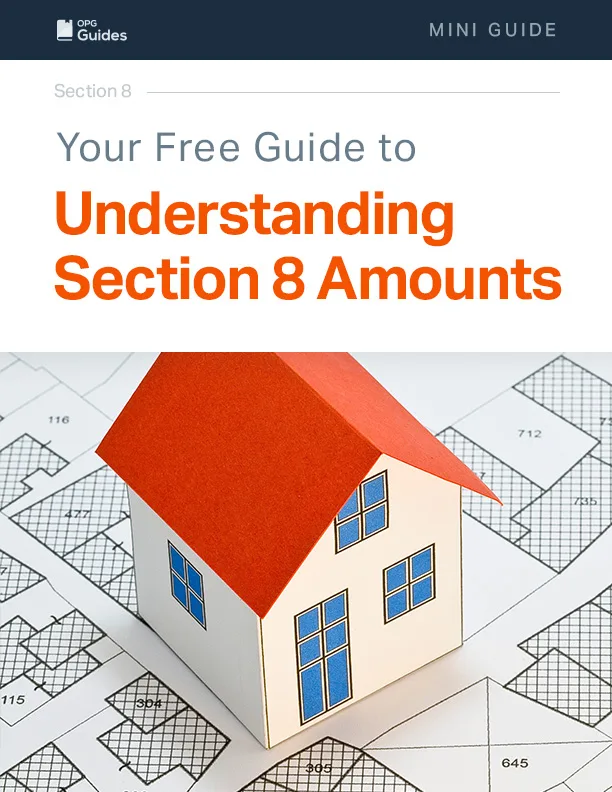Your Free Guide to Section 8 For Seniors
Your Free Guide to Section 8 For Seniors
We are privately owned and not affiliated with the government in any way or form.

Introduction
Housing assistance programs can serve as a lifeline for seniors and disabled individuals seeking safe, affordable housing. There are several programs that take special considerations for vulnerable populations, such as elderly Americans and those with disabilities.
Seniors and disabled individuals are among several populations who often struggle to find affordable housing to fit their needs. Whether they require physical accommodations, such as ramps or grab bars, or need assistance with finding safe, sanitary housing, these programs can act as a bridge for many people.
In this guide, you can learn more about housing assistance programs and options that cater specifically to the needs of these individuals. By exploring the program requirements, application processes, and unique resources available to seniors, senior veterans, and disabled individuals, this guide can serve as a resource for those seeking to learn more about these specialized programs.
Section 8: Housing Choice Voucher Program
Section 8 is one of the largest and most popular government assistance programs. Formally known as the Housing Choice Voucher Program, it pays a portion of the monthly rental costs for qualified individuals living in a unit that participates in the program.
Seniors and individuals with disabilities may find that Section 8 is a suitable program. It is run locally through Public Housing Agencies (PHAs), many of which have special conditions for seniors and disabled individuals who are approved for vouchers. Continue reading to learn more about the requirements of the program.
Program Requirements for Seniors and Disabled Individuals

The Section 8 program is one of the largest affordable housing initiatives. It serves the general public, but also addresses the needs of seniors and disabled individuals. Vulnerable populations often struggle to find safe, affordable housing, and the Section 8 program acts as a bridge toward a solution for many individuals with housing needs. This proactive approach recognizes the specific challenges faced by these groups and aims to provide them with stable and comfortable living environments.
Whether you’re a senior seeking peaceful retirement years or an individual with disabilities striving for independence, Section 8 could be your avenue to secure housing. Let’s delve deeper into the program’s qualification criteria and benefits offered by the program.
- Considerations for Seniors
Seniors are afforded the opportunity to apply for Section 8 assistance. Depending on the Public Housing Agency (PHA) to which they apply, they may even receive priority on the waiting list.
Many PHAs have waitlists due to high demand for housing. Those that do often have priority, which allows certain qualified individuals to move up the list faster than others. This helps ensure that the individuals with the most housing needs receive assistance as soon as it becomes available.
- Considerations for Disabled Individuals
The Section 8 program does not discriminate against disabled individuals of all ages. They are allowed the same rights as other applicants, provided they meet the Section 8 requirements. The Section 8 program also may allow disabled applicants and participants to request reasonable accommodations. These can include things like extra time to search for a Section 8 apartment or an extra bedroom that may be required for medical equipment or other purposes.
- Income Limitations
An integral facet of eligibility is the consideration of income limitations. Typically, these limits are set at around 50% of the median income for the specific area in which an applicant resides. This ensures that Section 8 assistance is directed to those with genuine financial need.
The program recognizes that seniors and disabled individuals often encounter higher medical expenses due to their unique circumstances. As a thoughtful provision, Section 8 permits deductions for medical costs. These deductions serve to lower their effective income, ultimately resulting in reduced rental payments, thus facilitating their access to affordable housing.
Visualizing the Benefits
For a clearer understanding, let’s compare the Section 8 program’s provisions for seniors and disabled individuals with those of conventional housing assistance programs:
| Criteria | Section 8 | Conventional Programs |
|---|---|---|
| Disability Inclusion | Welcomes disabled individuals of all ages | May have limited accommodations for disabilities |
| Income Consideration | Accounts for medical deductions to lower effective income | Strict income thresholds |
| Inclusivity | Emphasizes inclusivity and accessible housing | Less emphasis on disability accommodation |
How Section 8 Can Help Seniors and Disabled Individuals
The Section 8 program stands as a beacon of support, offering assistance that addresses the unique needs of seniors and disabled individuals. This vital initiative goes beyond the standard housing support by acknowledging and accommodating the specific requirements of these two distinct groups. Let’s delve into how Section 8 Housing is meticulously designed to cater to the well-being and comfort of seniors and disabled individuals.
Accessible Housing: Creating Inclusive Living Spaces
Central to the Section 8 program’s commitment is the provision of accessible housing units. These units are not just about offering a place to reside; they’re about creating homes that seniors and disabled individuals can navigate with ease and independence.
Section 504 of the Rehabilitation Act of 1973 protects the rights of people with disabilities. It states the following:
“No qualified individual with disabilities should, solely by reason of his or her disability, be excluded from the participation in, be denied the benefits of, or be subjected to discrimination under any program or activity receiving federal financial assistance.”
While not all Section 8 units were built prior to this law coming to fruition, disabled individuals who are accepted into the Section 8 program can rely on this provision to ensure they receive fair treatment. This law extends not only to the physical features of the units themselves, but also to the application process, program requirements, tenancy and eviction.
Many Section 8 housing units have been created with a focus on accessibility. It is not uncommon to find units participating in the program with features such as ramps, widened doorways, and strategically placed grab bars that transform living spaces into safe havens. This design philosophy ensures that daily routines, movements, and tasks are hassle-free, fostering a living environment that promotes dignity and self-reliance.
Rent Calculation: Acknowledging Financial Realities
The financial landscape for seniors and disabled individuals often comes with unique challenges, including higher medical and healthcare costs. Unlike conventional housing arrangements, where fixed rental costs might strain already limited budgets, Section 8 adapts by factoring in the individual’s income.
Medical expenses and healthcare costs are considered, resulting in rental payments that align with their financial capacities. This calculation method can help alleviate some of the burden on seniors and disabled individuals, allowing them to focus on their well-being without sacrificing their housing stability.
Housing Autonomy: Choice and Control for Improved Quality of Life
The concept of “housing choice” is a defining feature of the Section 8 program—one that can enhance the lives of seniors and disabled individuals. Instead of being assigned housing, program beneficiaries are empowered to select a dwelling that resonates with their preferences and needs.
Whether it’s an apartment within a complex or a private residence, this choice empowers individuals to curate their living space to suit their unique circumstances. This autonomy goes beyond bricks and mortar; it contributes to a renewed sense of control and agency over one’s life.
Comparative Overview: Traditional Housing vs. Section 8
| Aspect | Traditional Housing | Section 8 Housing |
| Accessibility | Variable accessibility features | Guaranteed accessibility standards for qualified individuals with a known disability (Section 504) |
| Rent Calculation | Fixed costs | Income-based, inclusive of healthcare expenses |
| Housing Selection | Limited choice | Empowered housing autonomy |
All in all, the Section 8 program stands as an example of how tailored support can uplift the lives of seniors and disabled individuals. By providing accessible housing and fair rent, this program fosters environments where dignity, independence, and comfort flourish.
Applying for Section 8 Assistance

Applying for Section 8 assistance can greatly benefit seniors and individuals with disabilities by providing them with affordable housing options. The process involves several important steps that ensure a smooth transition to suitable housing.
- Locate a Public Housing Agency (PHA)
The cornerstone of initiating your Section 8 application is identifying the local Public Housing Agency (PHA) responsible for managing the program in your area. PHAs play a pivotal role in assessing eligibility, managing waiting lists, and overseeing the administration of housing vouchers. You can easily locate your PHA by visiting the official website of the U.S. Department of Housing and Urban Development (HUD) or contacting their toll-free number.
The Section 8 National Customer Service Center is open weekdays from 9 PM to 5 PM EST. Be sure to have your name, email address, phone number and question ready before you call.
To contact the National Customer Service Center, call 800-955-2232.
- Complete the Application
Filling out the Section 8 application is a critical step that demands careful attention to detail. The comprehensive application form collects vital information about your household composition, total income, and disability status. By providing accurate data, you enable the PHA to accurately determine your eligibility and calculate the appropriate level of housing assistance you qualify for. This stage sets the foundation for a successful application process.
- Waitlist Placement
Upon submission of your application, you’ll be placed on a waiting list. It’s important to note that due to the high demand for housing assistance, waiting times can vary significantly based on factors such as location and availability of funds. While waiting, stay informed about your application status by regularly contacting the PHA and updating any changes to your contact information. Remember, patience is key during this phase, as your turn will come.
- Voucher Issuance
When your name reaches the top of the waiting list, you’ll receive a housing choice voucher. This voucher is a valuable asset that empowers you to explore housing options within your community. It’s important to understand the time frame within which you must utilize the voucher, as expiration dates can vary. This is where having a well-organized list of potential housing units can expedite your search and decision-making process.
- Inspection and Approval
Before you can move into your chosen housing unit, it must undergo a thorough housing quality inspection. This step ensures that the property meets the required health and safety standards. It’s a vital aspect that safeguards your comfort and well-being in your new home. Upon approval of the property, you can proceed to finalize the rental agreement with the landlord, making your transition seamless.
For more detailed information on filling out a Section 8 application, you can check out our free guide about the Section 8 application process.
Senior Veterans: The HUD-VASH Program
As senior veterans who have bravely served our nation, you deserve not only our gratitude but also our unwavering support in your golden years. The HUD-VASH program stands as a testament to our collective commitment to ensuring that no veteran is left without a roof over their head or the care they deserve. This collaborative effort between the Department of Housing and Urban Development (HUD) and the Veterans Administration (VA) is a beacon of hope, providing tailored assistance to homeless senior veterans through a unique blend of housing vouchers and specialized VA case management.
Benefits and Impact
The HUD-VASH program is a lifeline for senior veterans who are experiencing homelessness or housing instability. By combining housing vouchers with specialized VA case management, this program addresses both the immediate need for housing and the underlying factors that may contribute to homelessness. This comprehensive approach has led to tangible improvements in the lives of countless senior veterans, offering them a chance to rebuild their lives with dignity.
Let’s take a closer look at the benefits:
- Stable Housing: Housing instability can exacerbate existing health issues and create additional stress. The HUD-VASH program ensures that senior veterans have a stable and secure place to call home, providing them with the foundation they need to improve their overall well-being.
- Holistic Support: The VA case management component of HUD-VASH goes beyond housing. It encompasses a range of services designed to address various aspects of veterans’ lives. This includes physical and mental health support, addiction treatment, job placement assistance, and access to educational resources.
- Community Integration: The program encourages senior veterans to reintegrate into their communities. By providing housing in the private rental market, veterans have the opportunity to reside in neighborhoods of their choice, fostering a sense of belonging and social connectivity.
Section 202: Supportive Housing for the Elderly

Another comfortable and affordable housing option that seniors may seek in their golden years is Section 202, a federally funded housing program designed to provide safe, suitable, and affordable housing for elderly individuals and persons with disabilities.
Understanding Section 202
Section 202, often referred to as the “Supportive Housing for the Elderly” program, is a part of the United States Department of Housing and Urban Development (HUD). Established under the Housing Act of 1959, Section 202 addresses the housing challenges faced by seniors on fixed incomes who may also need access to supportive services to maintain their independence and quality of life.
Program Requirements
To qualify for Section 202 housing, individuals must generally meet certain criteria:
- Age Requirement: Applicants must be 62 years of age or older. In some cases, individuals with disabilities under the age of 62 may also be eligible.
- Income Limits: Section 202 is intended for seniors with limited financial resources. Eligibility is based on income, and applicants’ income must be below a certain threshold, usually around 50% of the median income in the area.
- U.S. Citizenship or Eligible Immigration Status: Applicants must be U.S. citizens or have eligible immigration status to apply.
- Need for Supportive Services: While not a strict requirement, preference is often given to applicants who require assistance with activities of daily living, such as cooking, cleaning, and personal care. This is to ensure that the housing meets the unique needs of its residents.
Benefits of Section 202
Enrolling in the Section 202 program offers numerous benefits tailored to seniors:
- Affordability: The program provides rent subsidies, making housing affordable for those with limited income. Rent payments are generally set at 30% of the resident’s adjusted income.
- Supportive Services: Many Section 202 housing communities offer or coordinate with service providers to deliver assistance like meal delivery, transportation, health monitoring, and social activities, allowing residents to age in place comfortably.
- Community: Section 202 developments foster a sense of community among residents, offering social and recreational activities that combat isolation and promote interaction.
- Accessibility: Housing units in Section 202 properties are designed with seniors in mind, often featuring accessible layouts, grab bars, and other modifications that facilitate aging in place.
Application Process
Applying for Section 202 housing involves several steps:
- Locate Properties: Use HUD’s online resources or contact local housing agencies to find Section 202 properties in your area.
- Contact Property Management: Reach out to the management of the chosen property to inquire about availability and application procedures.
- Complete Application: Fill out the required application forms, providing accurate information about your income, age, and any supportive services needed.
- Income Verification: Submit income-related documents, such as tax returns and bank statements, to verify your financial eligibility.
- Waitlist: Due to high demand, many Section 202 properties have waitlists. Wait times can vary significantly depending on location and availability.
- Approval: Once a unit becomes available, the property management will review your application and determine your eligibility. If approved, you’ll receive an offer for a housing unit.
- Move-in: After accepting the offer, you can move into your new Section 202 housing unit. Enjoy the benefits of affordable, supportive, and age-friendly living.
In conclusion, Section 202 offers a valuable opportunity for seniors to enjoy safe, affordable, and supportive housing as they age. By understanding the program’s purpose, eligibility requirements, benefits, and application process, seniors and their families can make informed decisions that enhance their quality of life during their golden years.
To embark on this housing journey, interested individuals can start by researching Section 202 properties in their area and taking steps to secure a comfortable and welcoming new home.
Golden Years Retreat: Public Housing for Seniors
Public housing for seniors provides a crucial support system for elderly individuals seeking affordable and safe housing options.
Program Requirements
To qualify for public housing as a senior citizen, individuals must generally meet certain criteria, which may vary slightly depending on the specific housing agency and location. Common eligibility requirements for seniors include:
- Age: Typically, applicants must be at least 62 years of age or older to be considered for senior public housing programs.
- Income Limit: There is often an income threshold that applicants must not exceed to qualify for senior public housing. This limit varies based on the area’s median income and family size. Eligibility is usually determined by comparing the applicant’s income to a percentage of the median income.
- Residency Status: Applicants must be legal U.S. citizens or eligible non-citizens to qualify for public housing.
Catering to Seniors
Public housing for seniors is designed to address the specific needs of elderly individuals, providing them with a safe and supportive environment. Here are some key ways public housing caters to seniors:
- Accessibility: Many senior public housing units are designed with accessibility features such as ramps, handrails, wider doorways, and other amenities that accommodate mobility challenges.
- Social Services: Some public housing communities offer social and recreational activities tailored to seniors, fostering a sense of community and combating isolation.
- Supportive Amenities: Public housing for seniors may offer amenities like community centers, fitness facilities, and medical assistance programs to cater to their unique needs.
Application Process
Applying for public housing as a senior involves a few essential steps:
- Locate Housing Agency: Identify the local housing agency in your area that administers senior public housing programs.
- Gather Documents: Prepare necessary documents such as proof of age, income verification, and residency status.
- Complete Application: Fill out the senior public housing application accurately and provide all required information.
- Submit Application: Submit the application by the specified deadline through the designated channels, which may include online platforms or in-person submission.
- Waitlist Placement: After submitting the application, applicants are placed on a waitlist. The waiting period can vary based on factors like demand and availability.
- Application Review: Housing agencies review applications to verify eligibility. Applicants may be contacted for further documentation or interviews if necessary.
- Notification: Once eligible, applicants are notified about their acceptance into the program. If ineligible, applicants may receive information about reasons for denial and potential next steps.
Public housing for seniors offers a lifeline of affordable, safe, and supportive housing solutions for elderly individuals. By understanding the eligibility requirements, benefits, and application process outlined, seniors can take steps towards securing a comfortable and welcoming home tailored to their needs.
Remember, each housing agency may have its own procedures and policies, so it’s essential to research your local options and reach out for assistance when needed.
Embracing Independence with Care: Navigating Assisted Living Facilities for Seniors

Assisted living facilities offer seniors a supportive and engaging environment where they can enjoy an independent lifestyle while receiving the assistance they require.
Program Requirements
Assisted living facilities typically cater to seniors who may require help with daily activities but do not necessarily need 24/7 medical care. Eligibility criteria often include age (usually 55+), the ability to participate in activities of daily living (ADLs) with some assistance, and the absence of severe medical conditions that would require constant medical supervision.
Catering to Seniors’ Needs
Assisted living facilities are designed to provide seniors with a balance between independence and assistance. They offer various services tailored to meet individual needs, including:
- Personal Care: Assistance with activities such as bathing, dressing, grooming, and medication management ensures seniors’ well-being.
- Nutritious Meals: Nutritional needs are met through well-balanced meals prepared on-site, often accommodating dietary restrictions.
- Engaging Activities: Facilities organize social and recreational activities that promote mental, physical, and emotional well-being.
- Housekeeping and Maintenance: Seniors can enjoy a clean and well-maintained living space without the worries of upkeep.
- Transportation: Scheduled transportation for medical appointments, shopping, and social outings keeps seniors connected to the community.
- 24/7 Support: Trained staff is available around the clock to provide assistance and ensure safety.
Application Process
- Research and Touring: Begin by researching assisted living options in your preferred area. Schedule tours to assess the facilities, amenities, and the atmosphere to ensure it aligns with your preferences.
- Assessment: Facilities often conduct an assessment of the senior’s needs and preferences to determine the level of care required.
- Financial Considerations: Understand the costs involved, including monthly fees, services covered, and any additional charges. Check if long-term care insurance, veteran benefits, or Medicaid can help cover expenses.
- Application Submission: Once a suitable facility is found, complete the application process. This may involve submitting medical records and personal information.
- Waiting Period: Depending on availability, there may be a waiting period before a spot becomes available.
- Transition Planning: Facilities often assist in creating a smooth transition plan, including arranging for transportation and coordinating move-in logistics.
Valuable Tips and Considerations
- Visit Multiple Facilities: Tour multiple facilities to make an informed decision about the best fit for the senior’s needs and preferences.
- Involve the Senior: Include the senior in the decision-making process to ensure their comfort and satisfaction.
- Read the Contract Carefully: Review the contract thoroughly before signing, paying close attention to fees, services, and policies.
- Plan for Future Needs: Consider how the facility can accommodate changing needs as the senior’s health evolves.
- Stay Connected: Regular visits and communication with seniors help them adjust and remain engaged in their new community.
Assisted living facilities offer seniors an opportunity to enjoy a vibrant and supported lifestyle in their golden years. By understanding eligibility requirements, the range of services provided, the application process, and considering valuable tips, seniors and their families can make an informed decision that aligns with their unique needs and preferences. Making this transition can empower seniors to embrace their independence while receiving the care and support they deserve.
Additional Tips and Resources for Seniors and Disabled Individuals
Navigating the world of affordable housing as a senior or an individual with disabilities involves more than just understanding the basics. Here, we delve deeper into crucial aspects that can make your journey smoother and your living situation more comfortable.
Reasonable Accommodations
The Fair Housing Act champions the rights of individuals with disabilities to request reasonable accommodations throughout the application and rental processes. What exactly does this mean?
It entails that you have the right to ask for modified application procedures or physical modifications to the housing unit that align with your needs. For example, if you use a wheelchair, you can request ramps or wider doorways to ensure your home is fully accessible. These accommodations are vital to ensure that your living space is tailored to your unique requirements.
Reporting Changes
Life is dynamic, and so are your circumstances. Whether it’s a change in income or alterations in your household composition, it’s essential to keep your PHA informed.
Accurate information is the cornerstone of fair rent calculations and prevents potential complications down the road. By promptly notifying your PHA about changes, you contribute to a more accurate representation of your housing needs, ensuring that the assistance you receive remains aligned with your situation.
Local Support Services
Beyond housing itself, many communities offer an array of support services specifically designed for seniors and disabled individuals. These services are tailored to enhance your overall quality of life, providing much-needed assistance in various aspects:
- Transportation Assistance: Many communities provide accessible transportation options, ensuring that you can move around conveniently and independently.
- Meal Programs: Access to nutritious meals might be available through local programs, alleviating any concerns about cooking or meal preparation.
- Home Healthcare Services: If you require medical assistance, home healthcare services can offer the support you need from the comfort of your own home.
- Social Activities: Engaging in community activities can combat isolation and promote social interaction, contributing to your mental and emotional well-being.
These local resources can significantly enhance your daily life and supplement the support provided by the Section 8 program itself.
Comparing Housing Options: Making Informed Choices

When considering housing options, it’s beneficial to have a clear comparison of available choices. We’ve created a simple chart below to help you evaluate potential residences based on your preferences and needs:
| Housing Option | Accessibility Features | Proximity to Services | Community Amenities | Estimated Cost |
| Option 1 | ||||
| Option 2 | ||||
| Option 3 |
Remember, this chart is just a starting point to help you organize your thoughts and requirements as you evaluate housing options.
Final Thoughts
Housing assistance programs can be powerful tools for seniors and disabled individuals to secure safe, affordable housing. The program requirements, accessible housing options, and specialized resources are designed to meet individuals’ unique needs.
As you embark on the application process, keep in mind that this assistance is not just about finding a home; it’s about empowering you to create a secure and fulfilling living environment. By understanding your rights, staying informed, and utilizing local resources, you can make the most of this program and enjoy a more enriched living experience.






